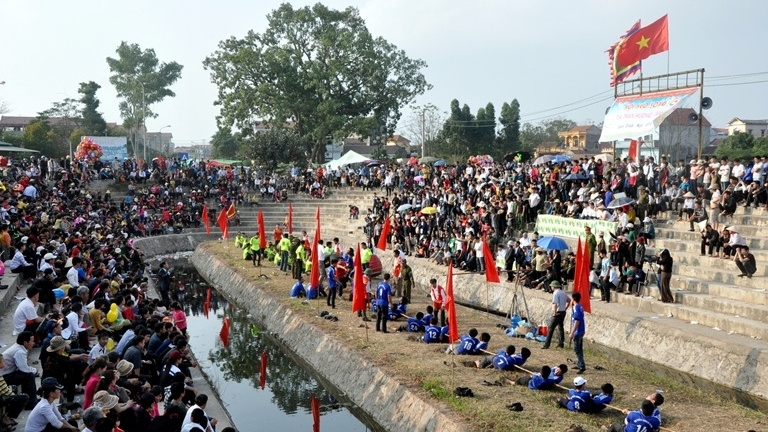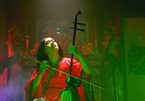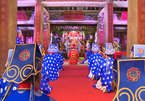 |
|
Huong Canh villagers in Binh Xuyen District, Vinh Phuc province joyfully participate in tug-of-war festival. (Photo: vietnamtourism.gov.vn) |
The safeguarding and promotion of the heritage’s value need further connection and exchange among communities of practitioners.
Tug-of-war is not only a folk game but also a team sport testing the strength and solidarity of participants. It conveys people’s aspirations for favourable weather conditions, bumper crops, happiness and prosperity.
Typically held near a communal house or shrine, two teams hold onto either end of a rope and try to tug it from the other.
The games and rituals are popular in midlands, Red river delta, and north central regions, but the way they are practiced are different in each locality due to differences in history and geological conditions.
The game is joyfully celebrated during spring festivals at the beginning of the year in Vinh Phuc Province, attracting enthusiastic participation from local residents regardless of age and gender.
The tug-of-war festival in Hoa Loan Village, Lung Hoa Commune, Vinh Tuong District, is observed from the fourth to the eighth days of the first lunar month to commemorate female general Le Thi Ngoc Chinh, who made significant contributions to the Trung sisters’ uprising against the Han invaders in 40 AD to reclaim national independence after more than 200 years of foreign rule.
Meanwhile, Huong Canh villagers in Binh Xuyen District host their annual tug-of-war festival from the third to the fifth days of the first lunar month to reproduce the Bach Dang Victory, which was led by Ngo Quyen (897-944) and put an end to over 1,000 years of Chinese domination.
An ancient form of sitting tug of war is still organised at the Tran Vu Temple Festival on the third day of the third lunar month in Thach Ban Ward, Long Bien District, Hanoi.
It is dated to a legend that during a serious drought, only one of 12 wells in Ngọc Tri Village still contained water, requiring men from Cho Hamlet to collect water from the well using bamboo twine.
However, they were stopped by men from Dia Hamlet. When a fight for the precious resource broke out, both sides were afraid of spilling the water, so they sat down and battled to pull the water from each other.
When the drought was over, the game was staged as a reflection of the fight at the village festival in order to wish for a better weather, a bumper crop and a prosperous life.
Prior to the game, each team consisting of 13-19 men made offerings to the village’s gods at the communal house.
In an effort to preserve and promote the value of the game and ritual, the Cultural Heritage Association of Vietnam (CHAV) in collaboration with the Hanoi Department of Culture and Information held a seminar themed ‘Tug of war game and communities of practitioners in Vietnam’.
The event attracted the participation of cultural researchers and managers as well as representatives from communities where the game is practiced, including Huong Canh Village, Binh Xuyen District, and Hoa Loan Village in Vinh Tuong District, Vinh Phuc Province; Huu Chap Village in Bac Ninh Province; Xuan Lai Village in Soc Son District; and Thach Ban Ward, Long Bien District, Hanoi.
The event provided a venue for communities of practitioners of the game to meet and exchange experiences for the first time after the game received UNESCO’s title in 2015.
According to Chairman of the CHAV Do Van Tru, UNESCO’s recognition of the tug-of-war games and rituals reflected the organisation’s appreciation for the value of the heritage. The accolade is also a source of pride for Vietnamese people, including communities of practitioners.
A majority of the participants expressed their hope that such event will be held annually so that they can meet and learn skills from other gamers while exchange ways to further promote the game in their communities.
They also stressed the need to strengthen connectivity among the communities of practitioners in order to uphold the cultural identity of the game.
In addition, they suggested the founding of a club for the Vietnamese tug-of-war practitioners’ communities, which is envisioned to support the communities in practicing the ritual and realising commitments to UNESCO.
The club also serves as a forum for practitioners to exchange their opinions and ways to safeguard and promote the heritage, thus consolidating the connectivity among communities of practitioners in Vietnam. Nhan Dan

Young artist destigmatizing folk singing with modern beats
Young singer Ha Myo has launched a unique music video combining traditional folk melodies of Xam singing and modern tunes between rap and electronic dance music genres. Let’s take a look!

Folk games and entertainment activities to be minimised at Keo Pagoda Festival
A major festival for residents in the Red River Delta is taking place in the Keo Pagoda in the northern province of Thai Binh.